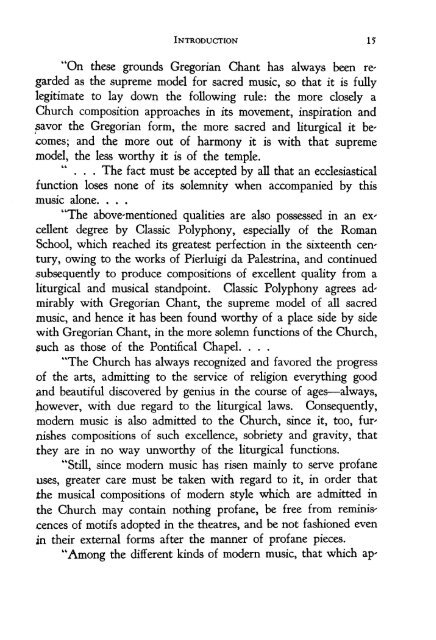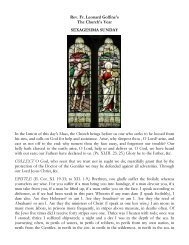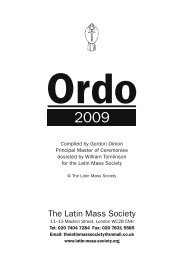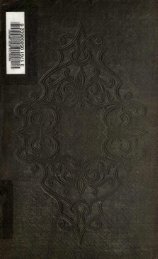The Spirit of Gregorian Chant - Church Music Association of America
The Spirit of Gregorian Chant - Church Music Association of America
The Spirit of Gregorian Chant - Church Music Association of America
Create successful ePaper yourself
Turn your PDF publications into a flip-book with our unique Google optimized e-Paper software.
INTRODUCTION 15<br />
"On these grounds <strong>Gregorian</strong> <strong>Chant</strong> has always been re'<br />
garded as the supreme model for sacred music, so that it is fully<br />
legitimate to lay down the following rule: the more closely a<br />
<strong>Church</strong> composition approaches in its movement, inspiration and<br />
savor the <strong>Gregorian</strong> form, the more sacred and liturgical it becomes;<br />
and the more out <strong>of</strong> harmony it is with that supreme<br />
model, the less worthy it is <strong>of</strong> the temple.<br />
" . . . <strong>The</strong> fact must be accepted by all that an ecclesiastical<br />
function loses none <strong>of</strong> its solemnity when accompanied by this<br />
music alone. . . .<br />
"<strong>The</strong> above-mentioned qualities are also possessed in an excellent<br />
degree by Classic Polyphony, especially <strong>of</strong> the Roman<br />
School, which reached its greatest perfection in the sixteenth century,<br />
owing to the works <strong>of</strong> Pierluigi da Palestrina, and continued<br />
subsequently to produce compositions <strong>of</strong> excellent quality from a<br />
liturgical and musical standpoint. Classic Polyphony agrees admirably<br />
with <strong>Gregorian</strong> <strong>Chant</strong>, the supreme model <strong>of</strong> all sacred<br />
music, and hence it has been found worthy <strong>of</strong> a place side by side<br />
with <strong>Gregorian</strong> <strong>Chant</strong>, in the more solemn functions <strong>of</strong> the <strong>Church</strong>,<br />
such as those <strong>of</strong> the Pontifical Chapel. . . .<br />
"<strong>The</strong> <strong>Church</strong> has always recognized and favored the progress<br />
<strong>of</strong> the arts, admitting to the service <strong>of</strong> religion everything good<br />
and beautiful discovered by genius in the course <strong>of</strong> ages—always,<br />
Jiowever, with due regard to the liturgical laws. Consequently,<br />
modern music is also admitted to the <strong>Church</strong>, since it, too, furnishes<br />
compositions <strong>of</strong> such excellence, sobriety and gravity, that<br />
they are in no way unworthy <strong>of</strong> the liturgical functions.<br />
"Still, since modern music has risen mainly to serve pr<strong>of</strong>ane<br />
uses, greater care must be taken with regard to it, in order that<br />
the musical compositions <strong>of</strong> modern style which are admitted in<br />
the <strong>Church</strong> may contain nothing pr<strong>of</strong>ane, be free from reminiscences<br />
<strong>of</strong> motifs adopted in the theatres, and be not fashioned even<br />
in their external forms after the manner <strong>of</strong> pr<strong>of</strong>ane pieces.<br />
"Among the different kinds <strong>of</strong> modern music, that which ap-
















